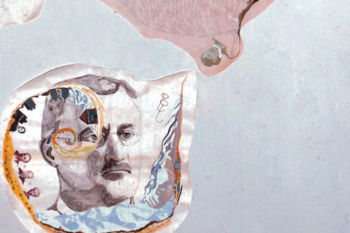Articles/Essays – Volume 46, No. 1
About the Art: Valerie Atkisson
“Tanner Spiral” is an exploration of my great-grandfather’s (Henry S. Tanner) family. He decided to take his first polygamous wife ten years after the first Manifesto. He had already been the mission president of the California mission and had completed law school at the University of Michigan. There is much family lore surrounding why this decision was made and the consequences of it. After his five wives were publicly known, his law firm at the time closed and many financial and other trials began. This piece is my attempt to explore and document this family’s experience.
I decided to use the medium of vellum after deciding that paper was too fragile a surface to work as a metaphor for this family. Vellum is goat skin that is treated and scraped many times to form the flexible, but nearly indestructible, surface that for generations has been used to keep records and illuminate books. The use of vellum is also a pun on the name of Tanner.
In permanent ink I wrote all of the known living descendants of each wife. Laura, the first wife, fills up two skins, as she had many more descendants than the subsequent wives. Using gouache, the traditional medium used on vellum, I painted stories of their lives that have been passed down to me—including places lived, schools attended, careers the women had after Henry could not fully support them, and other oral and written traditions. Among the wives were a Utah State representative, a stenographer, an adoption facilitator, and a missionary—all them full-time mothers with effectively 1/5 or less of a husband.
Henry’s middle skin contains a pictorial timeline of his life. He lost his mother and four siblings before he was fourteen when he ran away from home the same year his father took a wife in polygamy. He joined the army, and partook of the many vices available, only returning home after hearing the voice of his dead mother saying, “Henry, be a good boy.” From there is depicted his rise in education, professional and ecclesiastical attainment.
The skins are placed in a spiral going out from Henry’s middle skin. The spiral represents the effects of the decision to practice polygamy and the far-reaching consequences of it. The skins also represent the sacrifices the family made in all aspects of their lives to live this way. Henry and Laura believed that it was right to end polygamy in the Church, but that they were specially called to practice it.


 Back to full Issue
Back to full Issue

